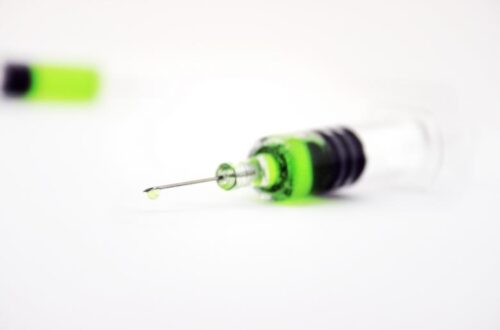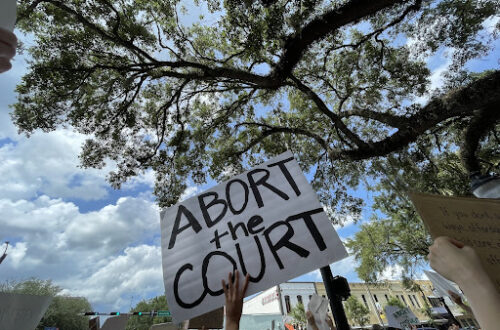Surrounded by women and children, some holding signs saying “Choose Life” or “I Am Pro-Life,” Florida Gov. Ron DeSantis signed HB 5, a divisive bill restricting abortion access 15 weeks after conception. It will go into effect July 1, 2022.
What has happened with abortion rights?
The ban includes narrow exceptions based on whether the mother or child would die. No exceptions were carved out for rape or incest cases.
Per the CDC, 92.7% of abortions occur before or at 13 weeks into pregnancy. Only 6.2% occur between 14 and 20 weeks post-conception.
On May 2, a bombshell report from Politico was released: The leaked draft majority opinion from the U.S. Supreme Court could overturn Roe and Casey if the final decision follows the wording of the draft.
With the leaked draft, patients in need of an abortion could be hundreds of miles away on average from a provider. Conservative estimates say 23 states could ban or severely limit abortion access as soon as the decision comes out.
In a Tweet to promote his signing of the bill, DeSantis wrote, “Florida Enacts Protections for Unborn Babies at 15 Weeks,” and stated in the accompanying video that he is there to “protect life” and “defend those who cannot defend themselves.”
The governor went on to claim that these “babies” have “beating hearts.” This heartbeat argument is often used at crisis pregnancy centers — facilities that serve to strongly dissuade women away from abortions, often deceitfully.
DeSantis’ claim regarding the fetus having a heartbeat is true, based on most medical consensus. However, pioneering research at the University of Leeds suggests that full heart formation may take 20 weeks. A majority of our current data is based on research on the gestation of animals — not humans — which is similar but not identical to our own.
Such discourse as this sits at the core of the debate over life and makes it clear that distinctions like a heartbeat cannot be used to concretely say a fetus is fully “alive.”
What can you do immediately?
Abortion providers urge those who still have an appointment in states like Florida to get their medical care. The Supreme Court decision is only final when formally published, and there is still a little under a month before the Florida bill becomes law.
Those seeking resources can find a provider on the National Abortion Federation website or call 1-800-772-9100 for information. Planned Parenthood can help you find both abortion and general reproductive healthcare services at their resource portal.
Those looking to organize or participate in a pro-choice demonstration can look for local efforts with Planned Parenthood via their network. Another action resource is NARAL, a pro-choice organization. They provide important data and resources.
Those who want to support financially can donate to the Planned Parenthood Action Fund, NARAL, the National Abortion Federation Patient Assistance Funds, or any of these state-specific funds.
What is the future of abortion rights?
We now sit in a nebulous period where people in potentially restrictive states are scrambling to determine how restrictions may affect them and what other states to resort to if they will need access to an abortion.
One organization that has undergone a plethora of efforts to inform its members is the UF College Democrats. As president of Planned Parenthood Generation Action in Gainesville and a leader in UFCD, Rachel Wolfrey helped organize a demonstration one day after the draft release.
On March 25, the UFCD Women’s Caucus had a painting session to paint small stones meant to decorate the walkway for a local Planned Parenthood. The Gainesville location provides most reproductive healthcare services but does not provide abortions.
Ironically, many pro-lifers protest reproductive health clinics such as Planned Parenthood over abortion care, even if the specific clinic does not provide abortions.
Amelia Packham, co-chair of the UFCD Women’s Caucus noted how activism efforts like the ones pushed by UFCD were done in part in response to “a recent surge in protests” in March. The initiative, organized by Packham and Caroline Rabideau, the caucus’ other co-chair, saw roughly 35 rocks painted with messages like “You are heard” and “You matter.”
In mid-April, Wolfrey organized to paint “Abortion is not a Dirty Word” on the 34th Street graffiti wall, a popular site for students to paint various political messages in Gainesville. The mural had “murder” written over it by an unknown individual, so they had to repaint it.
Supreme Court Justice Samuel Alito, the author of the draft opinion, seems to be set on returning abortion rights to the states. It will fall on the federal government to secure unified abortion rights by codifying Roe and expaning access.
The bill that could have achieved this was the Women’s Health Protection Act. It would have codified the right to an abortion and squashed any law opposing such rights by states.
The bill already passed the U.S. House but failed 49 to 51 in the U.S. Senate in a cloture vote.
All Republicans and Sen. Joe Manchin, D-West Virginia, voted against it. Earlier, Sen. Elizabeth Warren, D-Massachusetts, argued for the necessity to overturn the filibuster to protect abortion access so this exact scenario would not play out.
Sen. Susan Collins, R-Maine, and Sen. Lisa Murkowski, R-Alaska, both support abortion rights, though with greater limitations than the WHPA. They introduced a bill in February that has been criticized as too restrictive by a coalition of pro-choice groups.
Collins’ nay vote is especially significant, given her dogged support of two of the justices who may vote to overturn Roe. She was critical of how the WHPA bill did not carve out conscious exceptions for medical providers who have an ethical disagreement.
With congressional gridlock currently ongoing, what happens now will rest at the feet of activists. These art projects can unite communities and spread a message of hope in dark times.
Young activists can make a change if they can mobilize the vote. The path forward requires a continuation of these current efforts to activate the community and hold politicians responsible for voting on what they campaigned for.
Check out other recent articles from the Florida Political Review here.
Featured image: UFCD students painting rocks in support of a local Planned Parenthood. Photo by Ronin Lupien.





